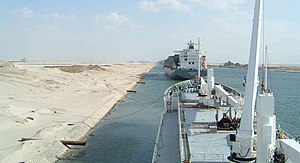Suezmax: Difference between revisions
mNo edit summary |
Ship length = unlimited |
||
| Line 6: | Line 6: | ||
| Ship tonnage = typically {{DWT|160,000}} |
| Ship tonnage = typically {{DWT|160,000}} |
||
| Ship displacement = |
| Ship displacement = |
||
| Ship length = |
| Ship length = unlimited |
||
| Ship beam = {{convert|77.5|m|abbr=on|0}} (maximum) |
| Ship beam = {{convert|77.5|m|abbr=on|0}} (maximum) |
||
| Ship height = {{convert|68|m|abbr=on|0}} (maximum) |
| Ship height = {{convert|68|m|abbr=on|0}} (maximum) |
||
Revision as of 02:03, 4 February 2017
| General characteristics | |
|---|---|
| Tonnage | typically 160,000 DWT |
| Length | unlimited |
| Beam | 77.5 m (254 ft) (maximum) |
| Height | 68 m (223 ft) (maximum) |
| Draft | 20.1 m (66 ft) (maximum) |



"Suezmax" is a naval architecture term for the largest ship measurements capable of transiting the Suez Canal in a laden condition, and is almost exclusively used in reference to tankers. Since the canal has no locks, the only serious limiting factors are draft (maximum depth below waterline), and height because of the Suez Canal Bridge.
Description
The current channel depth of the canal allows for a maximum of 20.1 metres (66 ft) of draft,[1] meaning that a few fully laden supertankers are too deep to fit through, and either have to unload part of their cargo to other ships ("transhipment") or to a pipeline terminal before passing through, or alternatively avoid the Suez Canal and travel around Cape Agulhas instead. The canal was deepened in 2009 from 18 to 20 metres (59 to 66 ft).
The typical deadweight of a Suezmax ship is about 160,000 tons and typically has a beam (width) of 50 m (164.0 ft). Also of note is the maximum head room—"air draft"—limitation of 68 m (223.1 ft), resulting from the 70 metres (230 ft) height above water of the Suez Canal Bridge. Suez Canal Authority produces tables of width and acceptable draft, which are subject to change.[2] From 2010, the wetted surface cross sectional area of the ship is limited by 1006 m2, which means 20.1 metres (66 ft) of draught for ships with the beam no wider than 50.0 m (164.0 ft) or 12.2 metres (40 ft) of draught for ships with maximum allowed beam of 77.5 metres (254 ft).[3]
The similar terms Panamax, Malaccamax, and Seawaymax are used for the largest ships capable of fitting through the Panama Canal, the Strait of Malacca and Saint Lawrence Seaway, respectively. Aframax tankers are those with a capacity of 80,000 tonnes deadweight (DWT) to 120,000 DWT. The term "Chinamax" refers to vessels able to use a number of harbours while fully laden. "Capesize" refers to bulk carriers too big to pass through the Suez Canal—and needing to go around the Cape of Good Hope—but recent dredging means many Capesize vessels can use the canal. Plans to deepen the draft to 70 feet (21 m) could lead to a redefinition of the Suezmax specification, as happened to the Panamax specification after deepening and widening of the Panama Canal.
See also
References
- ^ "Egypt's Suez canal H1 revenue, traffic up; upgrade helps". Reuters Africa. Thomson Reuters (af.reuters.com). 26 July 2010. Retrieved 26 March 2011.
- ^ Suez Canal Authority - Rules of Navigation
- ^ Suez Canal Authority - Beam and Draught Table

